The Galapagos!
We boarded an old rickety public bus, windows slid open for ventilation on a mega-humid day, and left the remote airport of Baltra for the main town of Puerto Ayora. The road crossed the rough desert scrub, nothing special, when suddenly the driver slammed on his brakes and the old bus reluctantly skidded to a stop. What on earth could have caused the driver to take such drastic action in such a remote place? Crossing the road, very slowly, was a giant tortoise, his large hardened shell supported by his fat stumpy legs, his head and neck stretched out to have a look, an animal possibly over 100 years old. This was his kingdom and he was in no hurry. After all, we were in the Galapagos and that’s just what happens here!
The name Galapagos conjures up great images – remote location, beautiful islands, unfettered wildlife, unique creatures. The Galapagos Islands are special in many ways but its biggest drawing card is the unique environment which has created a home for a fascinating range of animals, the most famous of which is probably the tortoise.
The environment is special primarily for two reasons. First, the remote location – the islands are almost 1,000 kilometres from the Ecuadorean mainland coast which over many thousands of years has protected the island’s flora and fauna from most outside influences, predators, competition, introduced species, diseases, etc. Second, these animals don’t hunt each other (with the exception of the jittery fish which seems to feed everyone) so they have no known predators and live peaceably side by side. How good is that?
The islands also have a unique history. They were probably accidentally discovered by passing ships blown off course in the 16th century and were infrequently visited by whalers, pirates and other passing ships for the next two hundred years. They became part of Ecuador in the 1830’s and were later used as a penal colony (answer to a good trivia question – what does Australia and the Galapagos have in common?). During World War II the US built an air field and military base on one of the small islands which after the war they handed over to Ecuador (which is the airport we landed at).
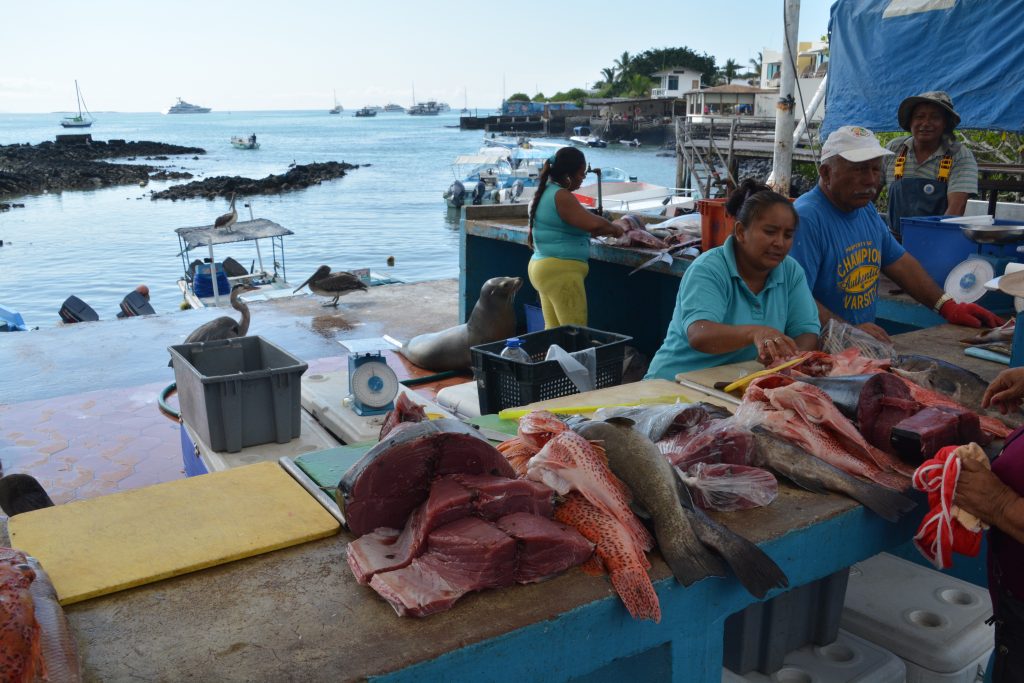
We walked around the town of Puerto Ayora and noticed a few unique features – such as this sea lion looking for free snacks at the fish market
But the fragile and unique eco-environment of the islands has taken some hits. Passing ships and early inhabitants introduced many new plants and animals, some of which devastated the unique wildlife and plants on the island. For instance, black rats ate all the baby tortoises on some islands and goats – which were introduced by whalers to help provide food – ate just about every plant in their path (as goats do). As a result, some unique species have become extinct and others are highly endangered.
The Ecuadorean government and many external organisations have worked very hard over recent years to eradicate these animals and bring the Galapagos back to its original state. Its an ongoing project and an impressive example of ecological conservation.
The Galapagos’ most famous visitor was the renowned naturalist Charles Darwin who came to the islands in 1835 on HMS Beagle. His studies of the animals on the different islands, and in particular how the different species of finches on the different islands developed different beaks to cater for the different food sources of each island led to his theories of evolution based on natural selection and the publication of his famous book Origin of the Species.
We walked down Charles Darwin Avenue (of course!) in the town of Puerto Aroyo that first afternoon, exploring the souvenir shops and taking in the whole scene. On the public jetty two sea lions were lounging in the shade while pelicans flew overhead and a huge sting ray swam under the pier. There was an area roped off down near the water where land iguanas were breeding. It really felt like we were walking around a natural zoo.
The next day we headed out early to the Charles Darwin Research Centre (of course!) to learn more about the fascinating work scientists are doing to save the different species of giant tortoises. The tortoises are the flagship animal of the islands and flourished here for thousands of years untouched until humans came along and almost drove them to extinction. These fascinating creatures, which can live for up to 250 years and reach 300 kilos (650 pounds), are now fully protected, heavily studied, much loved and as a result flourishing across the islands.
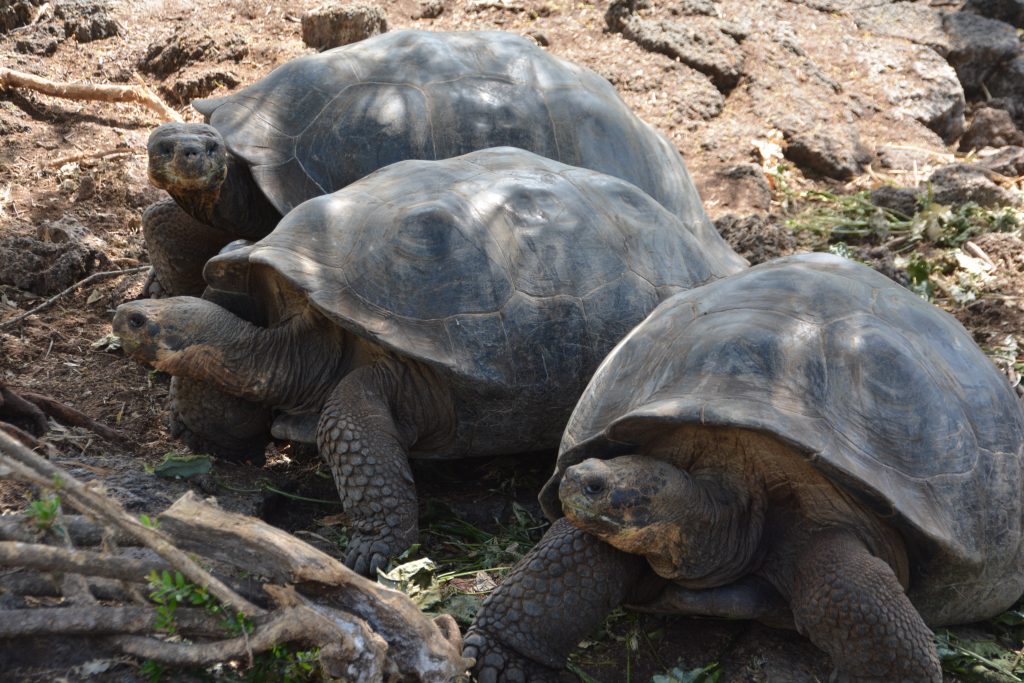
The Charles Darwin Research Centre gave us a good understanding of these amazing animals and the challenges they face
We then went down to the public jetty and were taken out to our new home for the next five days – the Archipell I, a stylish catamaran which sleeps 16 people plus crew. There we sat down with our shipmates, who were all in the middle of an eight day cruise and we were just joining them for the last five days. Never mind, they all seemed to be good fun and our matrimonial bedroom, as it was called, was small but super-comfortable.
That afternoon a bus took us to a private property where we wandered along the trails to see giant tortoises living in their natural habitat and walked through a long lava tunnel that was formed when a deep river of lava cooled and hardened on top but kept flowing underneath until the hot lava all flowed out, leaving a long hollow volcanic tunnel. That’s cool. The steamy hot weather was broken by a heavy tropical downpour that soaked all of us while we were hunting tortoises but added to the fun.
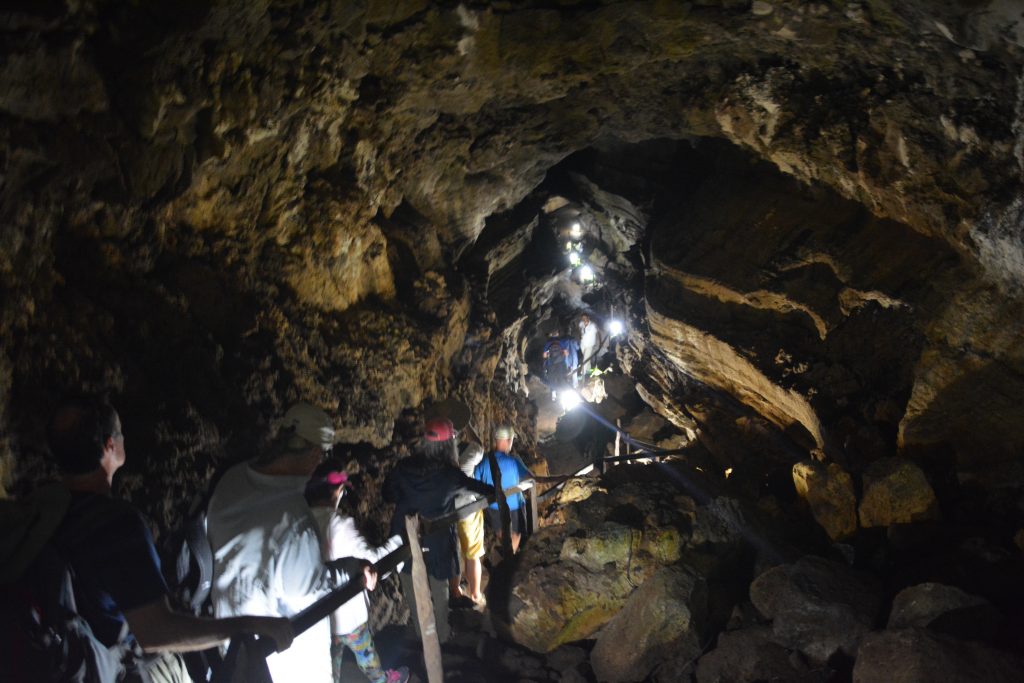
We also went into a very cool lava tunnel – not as big as the ones we’ve visited in Australia but much longer
That evening back on the Archipell 1 we got to know our fascinating eleven fellow shipmates a bit better (Michigan, Florida, Georgia, Switzerland, Austria, Israel! Doctors, firemen, nurses, teachers, lawyers!), dined well and from the observation deck on top of the ship were able to see the Big Dipper in the northern skies and the Southern Cross in the southern skies. That’s a trick only possible on the equator.
During the night we motored to the island of Floreana and in the morning boarded the zodiacs for a wet landing on a soft sandy beach which featured the famous blue footed boobies on the rocks and a sea lion lounging on the beach. Under a blazing sun we trekked inland to a small lake which had a group of about 25 flamingos – apparently a rare treat since the flamingo population on the islands is down to about 300. We then walked up and over to another beach where we saw marine iguanas, sea turtles, sting rays and more of the beautifully coloured Sally Lightfoot crabs. This was animal heaven – Julie and I had to keep pinching ourselves that we were in the Galapagos.
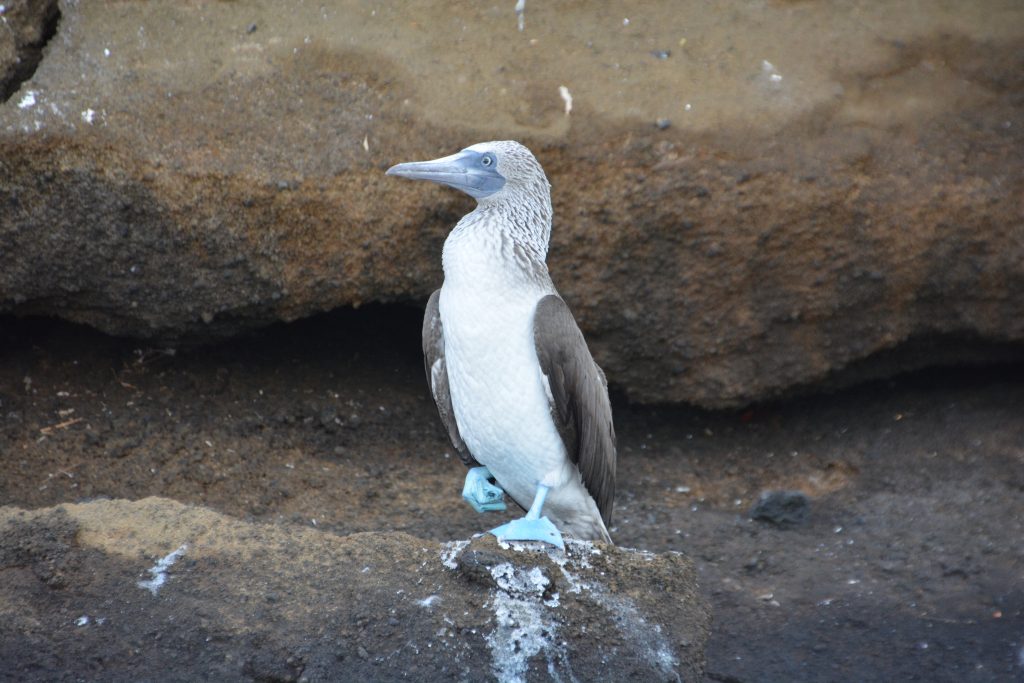
Our first blue footed boobie – a very cute bird we would become familiar with over the upcoming days

We were lucky to see this large group of flamingos as their numbers have been declining across the Galapagos
We had a great snorkel off the volcanic rocky shore and spotted many beautifully coloured fish in the warm water before lunch, the highlight perhaps a playful sea lion who slid off the rocky shore and swam right through us. With a group of only 13 we were getting to know our fellow travellers and found them all fairly like-minded and of similar vintage. The biggest difference was that all of them had flown in specifically to see the Galapagos and after the cruise would be flying back home again.
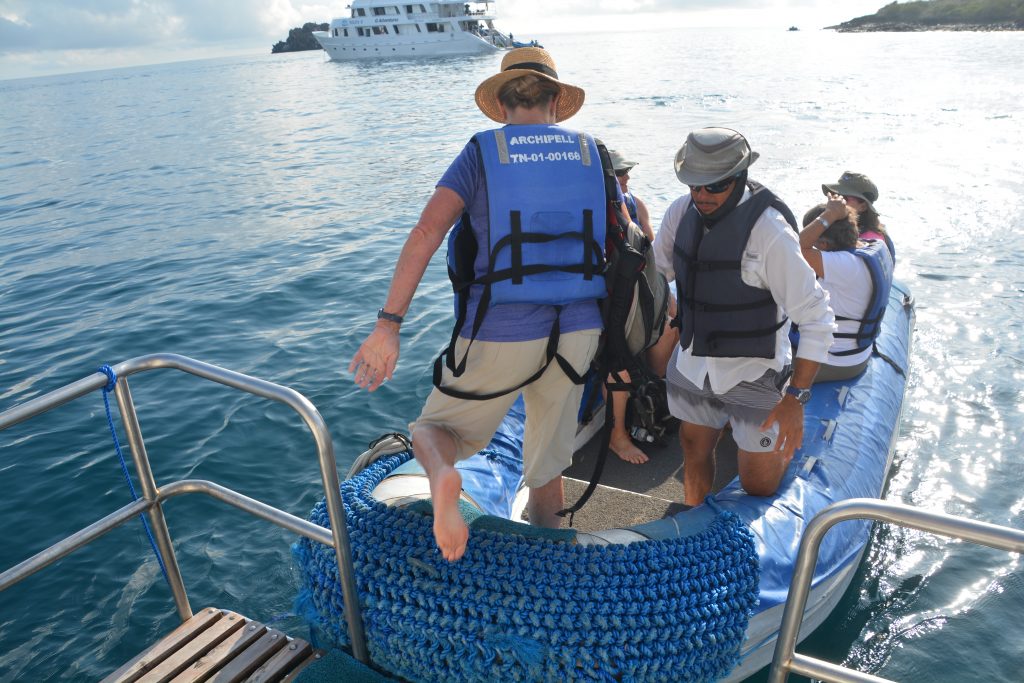
Julie boarding on of our zodiacs where life jackets were mandatory unless the staff forgot to bring them
After a post-lunch siesta we climbed back into the zodiacs for another land excursion. Tradition has it that crews of whalers, pirates and other passing ships would write letters and leave them in a special place on Floreana Island with the hope that another ship would come by and sailors would see a letter intended for a place they were going and personally deliver it. So the legend goes that this is the world’s only free postal service…but you have to be very patient. A few people in our group saw postcards addressed to people in their home town and agreed to take them home and hand deliver them. Kinda cool.
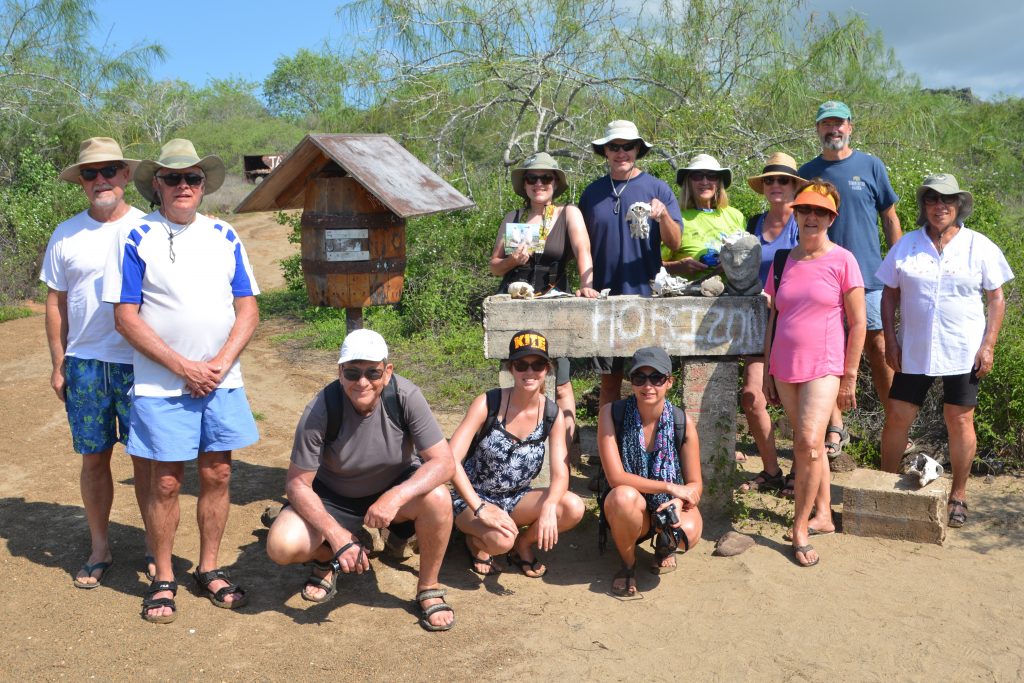
Our group posing at the post office on Floreana Island – keeping up a tradition that is centuries old
Based on our guide Gustavo’s advice, we put on our snorkel gear and went hunting for turtles. Not just any turtle but the huge Pacific Green Turtle which is often found off the island’s rocky shores. Sure enough, within minutes Julie and I found a huge turtle nibbling away at algae, then another, then another. In fact, at one stage all the snorkelers were crowded around these poor turtles like they were rock stars, which in Galapagos terms I guess they were. They lazily went about their feeding business, totally oblivious to the crowds they had drawn. Great stuff.
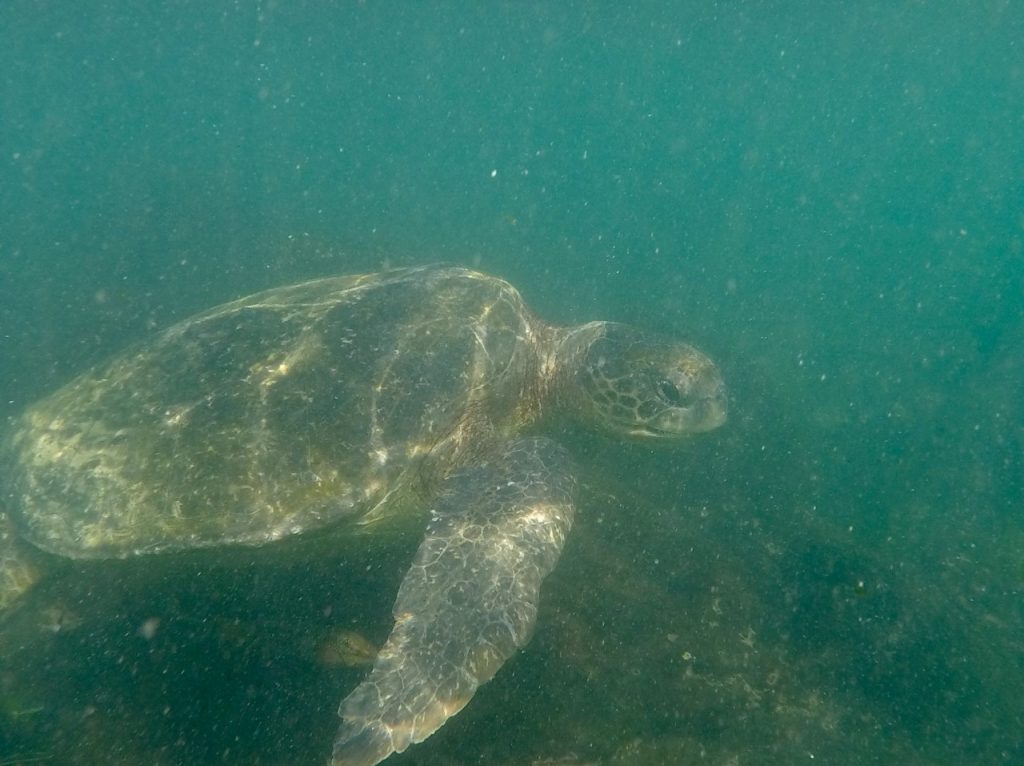
Snorkeling for Pacific Green Turtles was an instant success. All photos of turtles are courtesy of Ed who was our master underwater photographer.
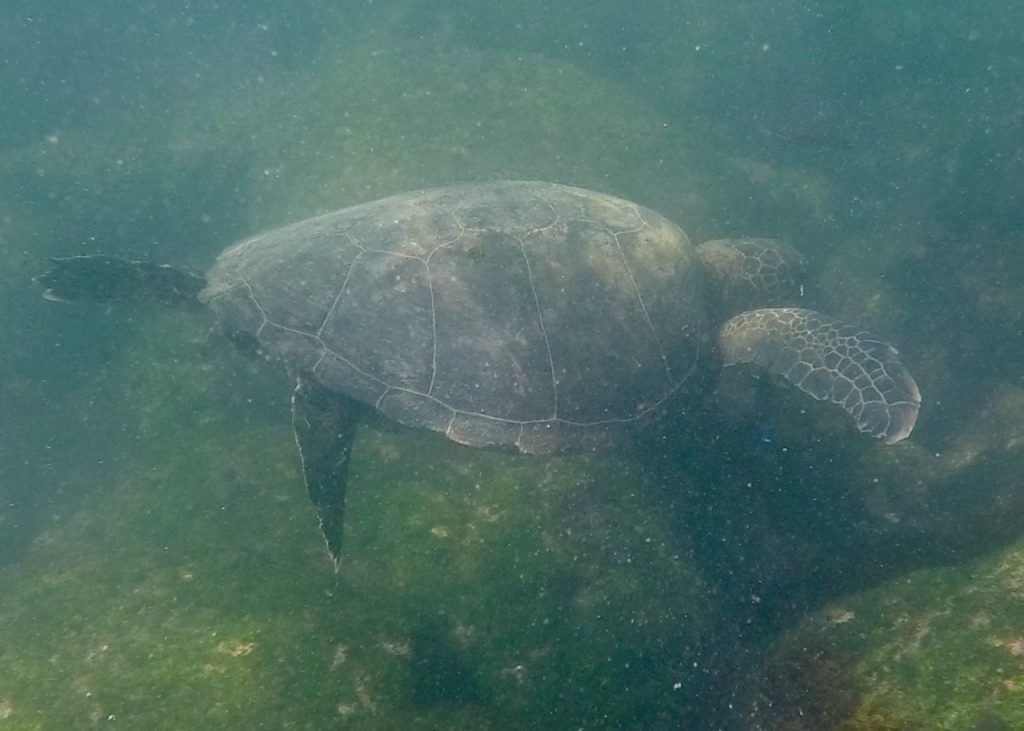
These guys would just go about their business without any worries of the audience they had drawn. Thanks Ed.
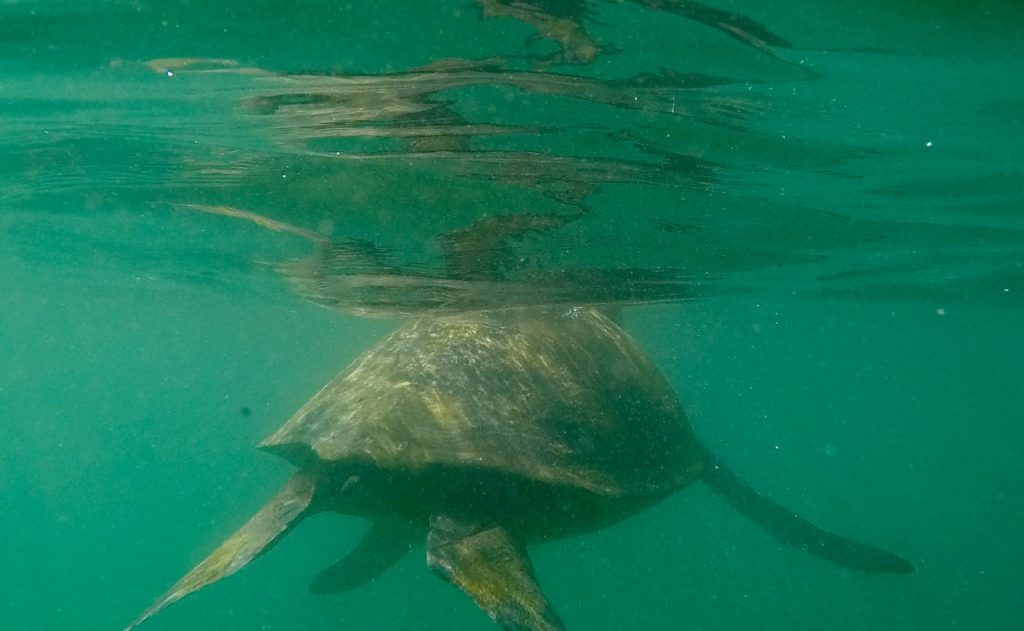
You didn’t want to be directly above a turtle when he decides to surface as he could literally swim right into you. Thanks Ed.
Our first couple of days in the Galapagos had been a dream come true but we knew there was more to offer over the next couple of days.
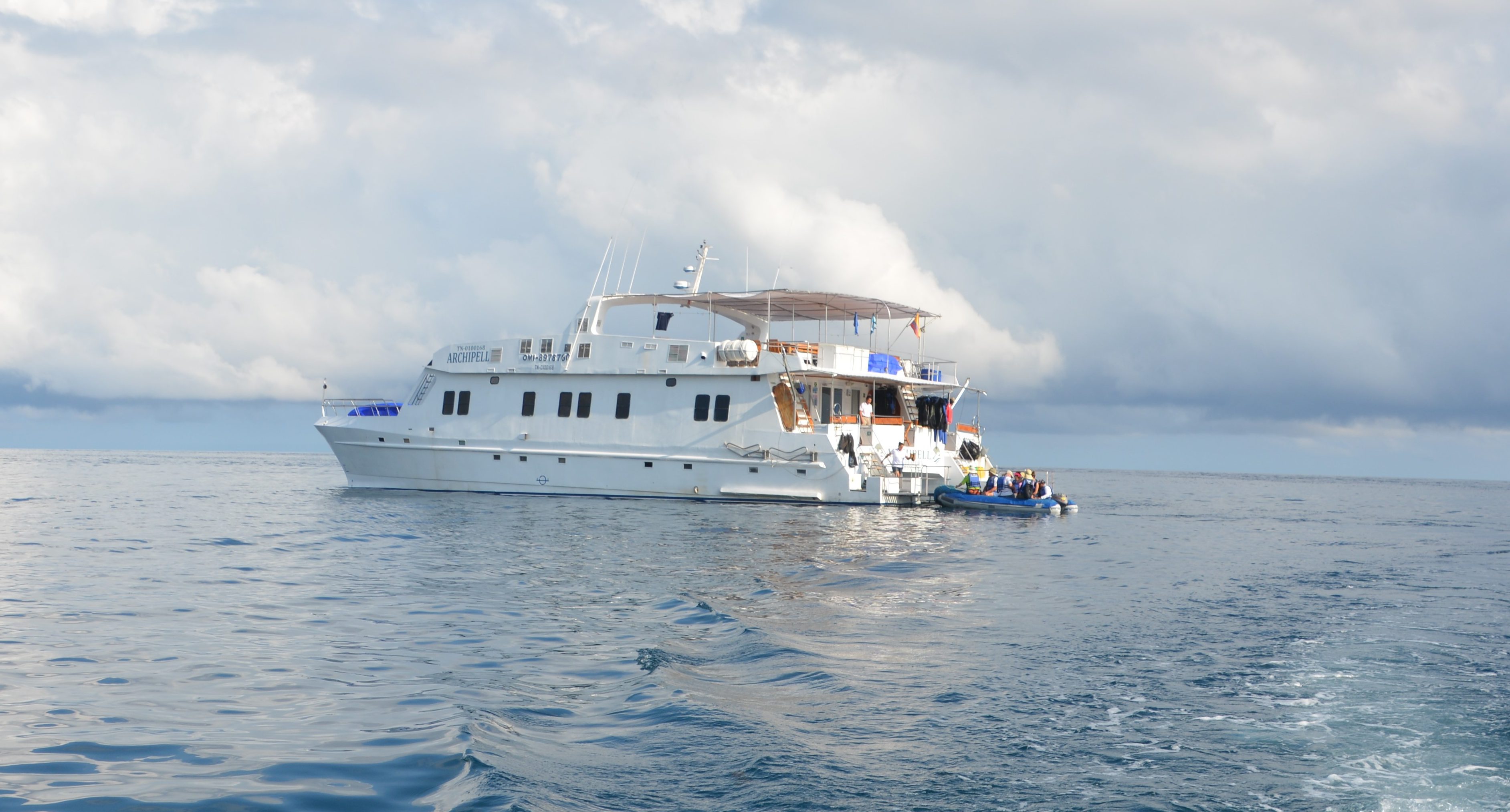
















Howdy Bill & Julie,
What an incredible place eh? Your photos bring back some wonderful memories of the amazing wildlife fauna there- so unafraid of the human visitors…just going about their daily routine business of feeding, mating, sunning themselves and generally having a playful time.
Hopefully things can stay that way for a long time to come. I heard recently that “Lonesome George” has passed away …he was well over a hundred years old when I saw this gentle giant, the last of his species of tortoise.
Happy travelling
Hi Susie. Yes, the Galapagos was an incredible place, just amazing. And yes, Lonesome George died a couple of years ago but they’ve preserved him and put him on display at the Darwin Research Centre to help tell his amazing story. Cheers, Bill
How absolutely amazing. A real Bucket List visit….you are living our dream xo